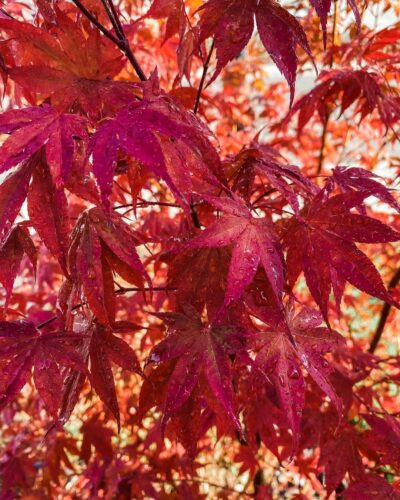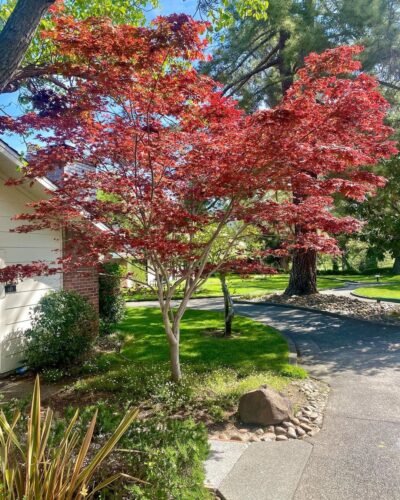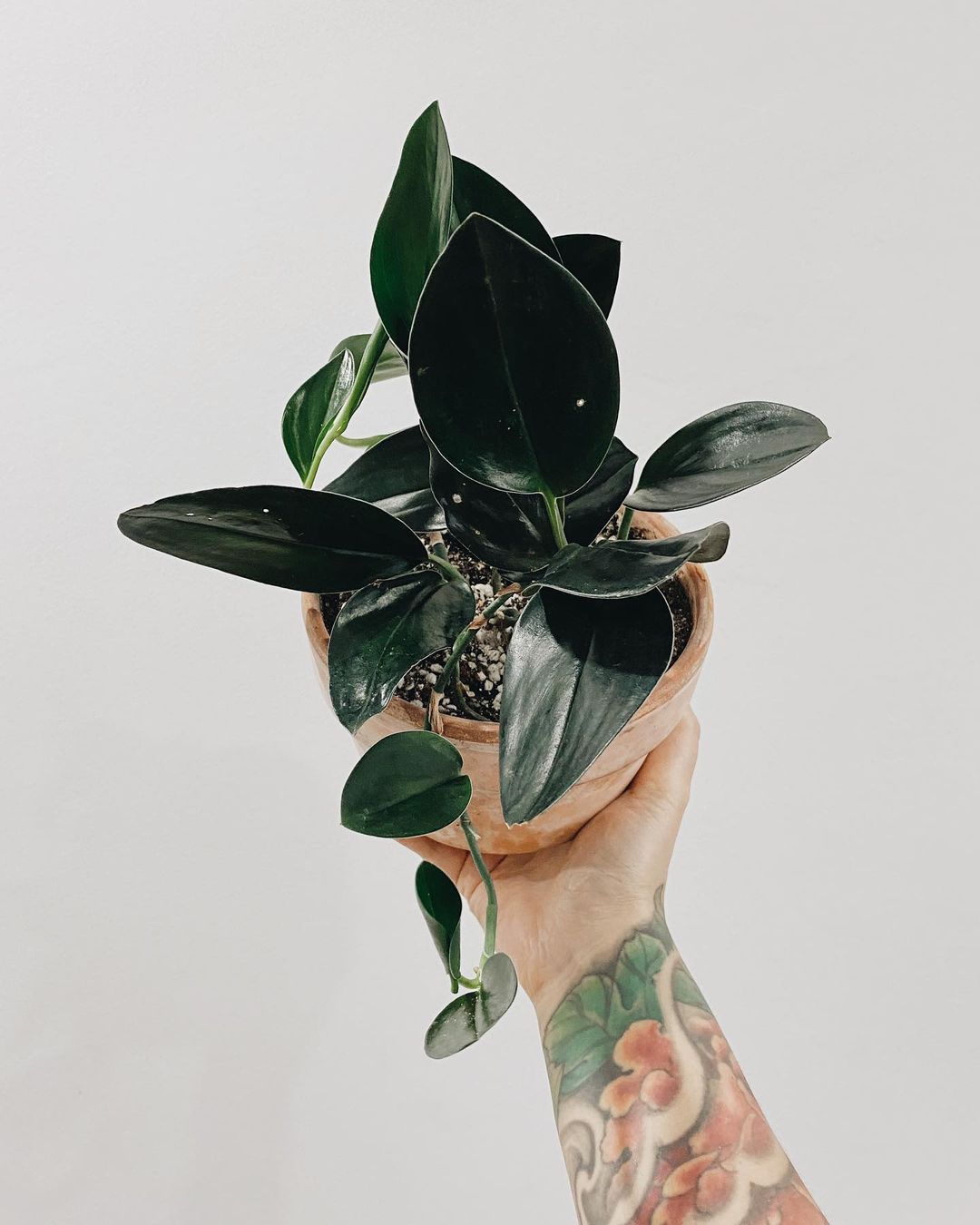Explore the Japanese Maple Fireglow vs. Bloodgood: Differences and Similarities comparison guide and find which suits your choice.
Compare Japanese Maple Fireglow vs. Bloodgood: Differences and Similarities guide. These stunning trees boast unique traits that set them apart while also sharing captivating features that make them beloved choices for landscapes.
Explore Elephant Bush vs. Jade Plant
About Japanese Maple Fireglow

Family: Sapindaceae
Botanical Name: Japanese Maple ‘Fireglow’, Acer palmatum ‘Effegi’
Native Place: Japan
Appearance: Japanese Maple Fireglow is a small deciduous shrub with a rounded shape. Its branches spread out gracefully. The leaves are palm-shaped with pointed lobes and have a deep reddish-purple color throughout the growing season.
Height: Typically reaches a height of 10 to 15 feet (3 to 4.5 meters).
Spread: Has a spread of about 8 to 12 feet (2.5 to 3.5 meters).
Flowers: Insignificant small purple or red flowers appear in spring, but they are not a prominent feature of the tree.
Foliage: The main attraction of Japanese Maple Fireglow is its foliage. The leaves emerge in spring with a fiery red color, turning to deep reddish-purple as they mature. The foliage provides a stunning display of color in gardens and landscapes.
Japanese Maple Fireglow is a popular ornamental tree in gardens and landscapes due to its vibrant foliage. It prefers partial shade and well-draining soil. The tree’s slow growth rate makes it suitable for smaller gardens or as a focal point in larger ones. Its striking foliage can add a splash of color to various garden styles and be particularly eye-catching when planted against a backdrop of greenery.
CHECK OUT Zucchini vs. Cucumber
About Bloodgood Japanese Maple

Family: Sapindaceae
Botanical Name: Japanese Maple ‘Bloodgood’, Acer palmatum atropurpureum ‘Bloodgood’
Native Place: Japan
Appearance: The Bloodgood Japanese Maple is a small to medium-sized deciduous tree with a rounded shape. Its branches spread out in an elegant manner. The leaves are deeply lobed and have a dark red or purple color throughout the growing season.
Height: Typically grows to a height of 15 to 20 feet (4.5 to 6 meters).
Spread: Has a spread of about 15 to 20 feet (4.5 to 6 meters).
Flowers: Insignificant small red or purple flowers appear in spring, but they are not a prominent feature of the tree.
Foliage: The main attraction of the Bloodgood Japanese Maple is its foliage. The leaves emerge in spring with a deep red or burgundy color, maintaining their vibrant hue during the summer months. The color intensifies in the fall, turning a brilliant scarlet before dropping.
The Bloodgood Japanese Maple is a popular ornamental tree known for its richly colored foliage. It thrives in partial shade and well-draining soil. The tree’s moderate growth rate makes it suitable for various landscape settings, from small gardens to larger yards. Its striking foliage provides a strong visual impact, especially when planted as a specimen tree or in groupings. This maple variety can add depth and contrast to landscape designs, making it a favored choice among gardeners and landscapers.
READ Japanese Beetle vs. June Bug
Japanese Maple Fireglow vs. Bloodgood: Similarities

Family and Origin: Both Japanese Maple Fireglow and Bloodgood belong to the same family, Sapindaceae. They both originate from Japan, where they naturally occur.
Deciduous Trees: Both trees are deciduous, meaning they shed their leaves in the fall and go dormant during the winter.
Leaf Shape: The leaves of both Japanese Maple Fireglow and Bloodgood are deeply lobed and palm-shaped, creating an intricate and delicate appearance.
Leaf Color: One of the most prominent similarities is their stunning foliage colors. Both trees have leaves that start off with vibrant red or burgundy tones in the spring and maintain their rich hues throughout the growing season. The colors intensify in the fall, turning brilliant shades of red, scarlet, or purple.
Ornamental Value: Both trees hold great value for their ornamental attributes, especially due to their striking foliage. People frequently choose them to infuse gardens and landscapes with color and visual allure.
Landscape Use: Gardeners use Japanese Maple Fireglow and Bloodgood in landscaping to create focal points, add texture, and bring vibrant color to various settings. They are suitable for small gardens as well as larger landscapes.
Maintenance: These trees share similar maintenance needs. They thrive in partial shade and well-draining soil. It’s a good idea to water them regularly and do some occasional pruning to keep their shape in check.
Aesthetic Contribution: Both trees contribute to the aesthetic appeal of outdoor spaces, providing a beautiful backdrop that showcases other plants and elements.
Cultural Significance: Japanese maples, including Fireglow and Bloodgood, hold cultural significance in Japanese gardens and are often associated with tranquility, elegance, and a connection to nature.
Explore Lavender vs. Lilac
Japanese Maple Fireglow vs. Bloodgood: Differences

1. Foliage Color: Japanese Maple Fireglow vs. Bloodgood
Fireglow: The Fireglow Japanese Maple is popular for its intense and vibrant red foliage. The leaves emerge in spring with a fiery red hue, which remains throughout the growing season. The color can be particularly striking when the tree is in bright sunlight.
Bloodgood: It also has red foliage, but its shade is deep wine-red. The color intensity may vary depending on the amount of sunlight the tree receives.
2. Leaf Shape and Size: Japanese Maple Fireglow vs. Bloodgood
Fireglow: Fireglow leaves are typically palmate (hand-shaped), with five or seven lobes. The leaves are medium-sized and have a slightly serrated edge.
Bloodgood: Bloodgood leaves are similarly palmate with five to seven lobes. The lobes of Bloodgood leaves tend to be more long and narrow compared to Fireglow leaves.
3. Leaf Texture: Japanese Maple Fireglow vs. Bloodgood
Fireglow: The leaves of Fireglow Japanese Maple have a smoother texture, and the margins may have a subtle waviness.
Bloodgood: Bloodgood’s leaves can sometimes have a slightly rougher texture than Fireglow, and the margins may be more deeply serrated.
4. Growth Rate: Japanese Maple Fireglow vs. Bloodgood
Fireglow: Fireglow Japanese Maple is known for its moderate growth rate. It usually reaches a mature height of around 10 to 15 feet with a similar spread over many years.
Bloodgood: Bloodgood Japanese Maple has a slightly faster growth rate than Fireglow. It can reach a mature height of 15 to 20 feet with a similar spread.
5. Sun Tolerance: Japanese Maple Fireglow vs. Bloodgood
Fireglow: Fireglow Japanese Maple benefits from some protection against intense afternoon sunlight, as its vibrant foliage can scorch under extreme heat.
Bloodgood: Bloodgood Japanese Maple is relatively more tolerant of sun exposure and can handle more direct sunlight without suffering from leaf burn.
6. Fall Color
Fireglow: Fireglow’s fall color tends to be a mix of red, orange, and even shades of purple, creating a beautiful fall display.
Bloodgood: Bloodgood’s fall color can range from red to crimson, adding a warm touch to the landscape.
7. Landscape Use
Fireglow: The intense red color makes it an excellent focal point in the landscape, particularly when placed against a backdrop of greenery.
Bloodgood: Bloodgood’s deeper, wine-red color is versatile and works well in various landscape settings, including Japanese gardens and mixed borders.
8. Growing Zones
‘Fireglow‘: It adapts to temperate climates, USDA Zones 5-9.
‘Bloodgood’: This variety thrives in USDA Zones 5-8, adaptable to many climates. With some care, you can plant it in mild low temperatures in USDA Zone 9.
9. Uses
Fireglow: Suits well for smaller landscapes, containers, and garden beds, where its compact size and round shape can be fully enjoyed.
Bloodgood: Appropriate for larger landscapes, as a focal point, and in spaces where its impressive height and captivating foliage can demand notice.
Explore Boysenberry vs. Blackberry



